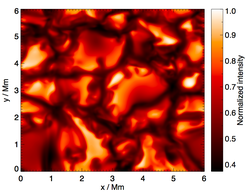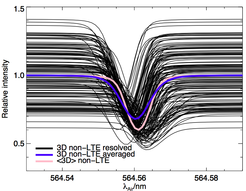
Accurate 3D non-LTE Stellar Spectroscopy

Continuum intensity at 500nm emergent vertically from a snapshot of a 3D hydrodynamical model solar atmosphere calculated by Remo Collet using the Stagger code.
Stars leave their signatures on the light that they emit, in the form of absorption and emission lines. This pattern of absorption and emission lines corresponds to the physical characteristics of the star -- for example its temperature, size, and chemical composition. Here on Earth, we observe this light and try to decipher this spectroscopic signature, in order to infer the physical characteristics of the star. This is called stellar spectroscopy.
For stellar spectroscopy to work, we need accurate models of how light travels through the stellar atmosphere. A problem with most analyses of cool stars today is that they are based on one-dimensional (1D) hydrostatic model atmospheres, and on the assumption of Saha-Boltzmann excitation-ionisation equilibrium as follows from the assumption of local thermodynamic equilibrium (LTE).

Vertical intensity in a neutral silicon line across the surface of the snapshot (credit: Anish Amarsi)
In collaboration with researchers in Australia, Denmark and Sweden, we are pioneering the use of non-LTE radiative transfer calculations through three-dimensional (3D) hydrodynamic model atmospheres of cool stars. These techniques are necessary in order to derive the chemical compositions of cool stars to accuracies of better than 0.1 dex.

